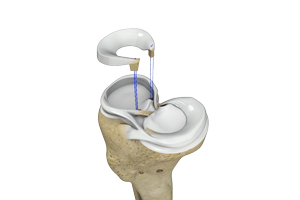
Meniscal transplantation is a surgical procedure to replace the damaged meniscus of the knee with healthy cartilage.
The meniscus is a C-shaped cartilage ring that acts as a cushion between the shinbone and the thighbone. Each of your knees has two menisci - one on the inside (medial aspect) and the other on the outside (lateral aspect)of your knee. Apart from the cushioning effect, the menisci also provide stability to the knee.
A meniscal tear is a common knee injury that usually occurs secondary to trauma and is common in athletes. A meniscal tear may also occur in the elderly due to degenerative changes in the knee. A damaged meniscus predisposes you to persistent pain, swelling, and arthritis.
Treatment of a meniscal tear depends on its type, severity, and location of the tear. Non-surgical options for the treatment of meniscal tears may include ice application, rest, elastic bandage, elevation, and physical therapy. However, a badly damaged meniscus may have to be removed. Knee replacement may be an option to consider in older individuals. However, meniscal transplantation can be an alternative option in younger patients.
Indications and Contraindications
The eligibility criteria for meniscal transplantation include:
- Young to middle-aged patients (below 50 years of age)
- Patients with stable, well-aligned knees
- Patients with intact or minimally damaged articular cartilage in the joint
- Patients who have already undergone a prior meniscectomy (removal of meniscus)
- Patients who complain of persistent activity-related pain
- Meniscal transplantation is not recommended for patients with severe arthritic changes within the joint
Diagnosis
A diagnosis of meniscal tear as a cause of knee pain comprises of a medical history along with the presenting symptoms followed by a physical examination of the knee. Your doctor may also order a few imaging studies such as an X-ray and MRI scan of the knee to rule out other possible diagnoses. X-rays help to identify degenerative changes such as osteoarthritis which can cause knee pain. MRIs help to visualize the menisci and assess the location and severity of the injury.
Procedure
- The goal of meniscal transplant surgery is to reduce pain and prevent arthritic changes. The surgery is performed under general anesthesia on an outpatient or inpatient basis.
- The procedure is usually performed with the help of an arthroscope (a fiber optic instrument), which is used to visualize the internal structures of the knee. A tiny camera is attached to one end of the arthroscope which transmits the internal images of the knee to a TV monitor. The arthroscope allows the surgeon to evaluate the entire knee joint including the cartilage, ligaments and the joint lining.
- The cartilage used for transplantation is derived from a human cadaver donor. The healthy donor cartilage is preoperatively customized to fit the patient’s knee.
- For the surgery, a surgical incision is made over the front of the knee in the area of the damaged meniscus. The damaged meniscus is removed and the site is prepared to receive the new meniscal implant.
- The new meniscus is implanted at the proper site under arthroscopic guidance. The new meniscus is then sutured to the surrounding tissue, for which an additional small incision is required. Screws or other fixation instruments are used to secure the meniscus in place.
- Depending on the severity and nature of the damage, additional procedures such as ligament or cartilage repair may also be performed along with the meniscal transplant.
Post-Operative Care
Following the surgery, you will be advised to wear a knee brace to support and protect the knee for the first 1 to 6 weeks. You will be required to use crutches after the surgery, to avoid any pressure or stress over the operated knee. You can start moving soon after the surgery to prevent knee stiffness. Pain relieving medications will be prescribed to control pain. A physical therapy program will help to restore the range of motion and strength of your knee. You may be able to resume work after a few weeks or a few months, depending on the nature of your work. It may take 6 to 12 months for you to return to playing sports.
Risks and Complications
Possible complications associated with meniscus transplantation include:
- Stiffness of the knee
- Persistent pain
- Infection
- Bleeding
- Nerve injury
- A tear of the new meniscus
- Incomplete healing
- Transplant dysfunction
- Small risk of disease transmission from the transplant
Related Topics
- Knee Arthroscopy
- ACL Reconstruction
- Knee Cartilage Restoration
- Meniscal Surgery
- Patellofemoral Knee Replacement
- Meniscus Replacement
- Cartilage Replacement
- PCL Reconstruction
- Knee Ligament Reconstruction
- Posterolateral Corner (PLC) Reconstruction
- Revision Knee Ligament Reconstruction
- Posterolateral Corner Reconstruction
- LCL Reconstruction
- MCL Reconstruction
- LPFL Reconstruction
- Medial Patellofemoral Ligament Reconstruction
- Quadriceps Tendon Repair
- Knee Fracture Surgery
- Meniscectomy
- Distal Realignment Procedures
- Partial Arthroscopic Meniscectomy
- Patellofemoral Realignment
- Failed Anterior Cruciate Ligament (ACL) Reconstruction
- Failed Meniscus Repair
- Lateral Lengthening
- Meniscal Transplantation
- Prior Meniscectomy
- Tibial Eminence Fracture
- ORIF of the Knee Fracture
- Bone-Patellar Tendon-Bone (BPTB) Autograft
- Bone-Patellar Tendon-Bone (BPTB) Allograft
- Hamstring Autograft
- Hamstring Allograft
- Knee Osteotomy
- High Tibial Osteotomy
- Tibial Tubercle Osteotomy
- Distal Femoral Osteotomy
- Multiligament Reconstruction of the Knee
- Patellar Tendon Repair
- Arthroscopic Reconstruction of the Knee for Ligament Injuries
- Autologous Chondrocyte Implantation
- Partial Meniscectomy
- Cartilage Microfracture
- Pharmacological Interventions for Knee Injuries
- Ultrasound-Guided Genicular Nerve Block
- Intraarticluar Knee Injection
- Viscosupplementation
- Physical Therapy for Knee








